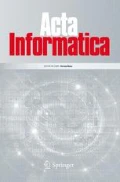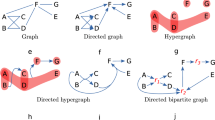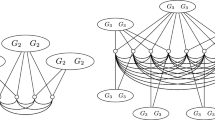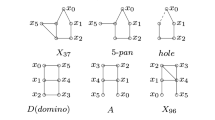Abstract
We present a simple model, called depleatable channels, of multi-hop communication in ad hoc networks. We introduce a model for channel energy consumption, and we propose a notion of channel equivalence based on the communication service they provide, regardless of specific routing protocols. In particular, we consider equivalent two channels with identical maximum and minimum inhibiting flow, and prove that this notion of equivalence, and variants of it, coincide with standard equivalences borrowed from the theory of concurrency. Unfortunately, while the maximum flow can be computed in polynomial time, calculating the value of a minimum inhibiting flow is NP-hard. Thus, we propose a characterization of those graphs, called weak, which admit charge assignments for which the minimum inhibiting flow is strictly less than the maximum flow and show that weakness can be checked efficiently by providing an algorithm that does so in polynomial time.












Similar content being viewed by others
Notes
Notation \(G|_U\), for every \(U \subseteq V(G)\), denotes the subgraph of G with nodes U and edges \(E(G) \cap (U \times U)\).
References
Aceto, L., Fokkink, W., Verhoef, C.: Structural operational semantics. In: Bergstra, J., Ponse, A., Smolka, S. (eds.) Handobook of Process Algebra, pp. 197–292. North-Holland, Amsterdam (2001)
Ahuja, R., Magnanti, T., Orlin, J.: Network Flows, Theory, Algorithms, and Applications. Prentice-Hall, Upper Saddle River, NJ (1993)
Akkaya, K., Younis, M.F.: A survey on routing protocols for wireless sensor networks. Ad Hoc Netw. 3(3), 325–349 (2005)
Akyildiz, I., Su, W., Sankarasubramaniam, Y., Cayirci, E.: A survey on sensor networks. IEEE Commun. Mag. 40(8), 102–116 (2002)
Beckmann, M., McGuire, C.B., Winsten, C.B.: Studies in the Economics of Transportation. Yale University Press, New Haven, CT (1956)
Borgström, J., Nestmann, U., Alima, L.O., Gurov, D.: Verifying a structured peer-to-peer overlay network: the static case. In: Global Computing, volume 3267 of LNCS, pp. 250–265. Springer (2005)
Boukerche, A. (ed.): Algorithms and Protocols for Wireless Sensor Networks. Wiley, New York (2009)
Bourke, T., van Glabbeek, R.J., Höfner, P.: Mechanizing a process algebra for network protocols. J. Autom. Reason. 56(3), 309–341 (2016)
Braess, D.: Über ein paradoxon aus der verkehrsplannung. Unternehmensforschung 12, 258–268 (1968)
Bres, E., van Glabbeek, R. J., Höfner, P.: A timed process algebra for wireless networks with an application in routing—(extended abstract). In: Proceedings of ESOP, volume 9632 of LNCS, pp. 95–122. Springer (2016)
Cenciarelli, P., Gorla, D., Salvo, I.: A polynomial-time algorithm for detecting the possibility of braess paradox in directed graphs. Algorithmica. A preliminary version is available at arXiv:1610.09320 (in press)
Cenciarelli, P., Gorla, D., Salvo, I.: Depletable channels: dynamics and behaviour. In: Proceedings of FCT09, volume 5690 of LNCS, pp. 50–61. Springer (2009)
Cenciarelli, P., Gorla, D., Salvo, I.: Inefficiencies in network models: a graph-theoretic perspective. Inf. Process. Lett. 131, 44–50 (2018)
Cenciarelli, P., Gorla, D., Tuosto, E.: Network applications of graph bisimulation. In: Proceedings of ICGT08, volume 5214 of LNCS, pp. 131–146. Springer (2008)
Cerone, A., Hennessy, M.: Modelling probabilistic wireless networks. Log. Methods Comput. Sci. 9(3) (2013)
Cerone, A., Hennessy, M.: Characterising testing preorders for broadcasting distributed systems. In: Proceedings of Trustworthy Global Computing, volume 8902 of LNCS, pp. 67–81. Springer (2014)
Cerone, A., Hennessy, M., Merro, M.: Modelling mac-layer communications in wireless systems. Log. Methods Comput. Sci. 11(1) (2015)
Chen, X., Diao, Z., Hu, X.: Excluding braess paradox in nonatomic selfish routing. In: Proceedings of SAGT15, volume 9347 of LNCS, pp. 219–230. Springer (2015)
Chen, X., Diao, Z., Hu, X.: Network characterizations for excluding braess’s paradox. Theory Comput. Syst. 1–34 (2016)
Cormen, T., Leiserson, C., Rivest, R.: Introduction to Algorithms. MIT Press, Cambridge (1990)
De Nicola, R.: Behavioral equivalences. In: Encyclopedia of Parallel Computing, pp. 120–127. Springer (2011)
De Nicola, R., Hennessy, M.: Testing equivalences for processes. Theor. Comput. Sci. 34, 83–133 (1984)
Ene, C., Muntean, T.: Testing theories for broadcasting processes. Sci. Ann. Cuza Univ. 11, 214–230 (2002)
Escalante, F.: Schnittverbände in graphen. Abhandlungen aus dem Mathematischen Seminar der Universität Hamburg 38(1), 199–220 (1972)
Fehnker, A., McIver, A.: Formal techniques for the analysis of wireless networks. In: Proceedings of IEEE-ISOLA. IEEE (2006)
Ford, L.R., Fulkerson, D.R.: Maximal flow through a network. Can. J. Math. 8, 399–404 (1956)
Ganjali, Y., Keshavarzian, A.: Load balancing in ad hoc networks: single-path routing versus multi-path routing. In: INFOCOM04, vol. 2, pp. 1120–1125 (2004)
Garey, M., Johnson, D.: Computers and Intractability: A Guide to the Theory of np-Completeness (1979)
Ghassemi, F., Fokkink, W., Movaghar, A.: Verification of mobile ad hoc networks: an algebraic approach. Theor. Comput. Sci. 412(28), 3262–3282 (2011)
Godskesen, J.C.: A calculus for mobile ad hoc networks. In: Proceedings of Coordination, volume 4467 of LNCS, pp. 132–150. Springer (2007)
Golumbic, J.: Algorithmic Graph Theory and Perfect Graphs. Academic Press, London (1980)
Helen, D., Arivazhagan, D.: Applications, advantages and challenges of ad hoc networks. J. Acad. Ind. Res. 2(8), 453–457 (2014)
Iri, M.: Theory of uncontrollable flows—a new type of network-flow theory as a model for the twenty-first century of multiple values. Comput. Math. Appl. 35(10), 107–123 (1998)
Jhaveri, D.R.: Mobile ad-hoc networking with AODV: a review. 6, 165–191 (2015)
Kanellakis, P., Smolka, S.: CCS expressions, finite state processes and three problems of equivalence. Inf. Comput. 86(1), 43–68 (1990)
Kloks, T., Kratsch, D.: Listing all minimal separators of a graph. SIAM J. Comput. 27(3), 605–613 (1998)
Lanese, I., Sangiorgi, D.: An operational semantics for a calculus for wireless systems. Theor. Comput. Sci. 411(19), 1928–1948 (2010)
Lanotte, R., Merro, M.: Semantic analysis of gossip protocols for wireless sensor networks. In: Proceedings of CONCUR, volume 6901 of LNCS, pp. 156–170. Springer (2011)
Macedonio, D., Merro, M.: A semantic analysis of key management protocols for wireless sensor networks. Sci. Comput. Program. 81, 53–78 (2014)
Merro, M.: An observational theory for mobile ad hoc networks (full version). Inf. Comput. 207(2), 194–208 (2009)
Merro, M., Ballardin, F., Sibilio, E.: A timed calculus for wireless systems. Theor. Comput. Sci. 412(47), 6585–6611 (2011)
Merro, M., Sibilio, E.: A calculus of trustworthy ad hoc networks. Form. Asp. Comput. 25(5), 801–832 (2013)
Mezzetti, N., Sangiorgi, D.: Towards a calculus for wireless systems. In: Proceedings of MFPS, volume 158 of ENTCS, pp. 331–353 (2006)
Miao, G., Song, G.: Energy and Spectrum Efficient Wireless Network Design. Cambridge University Press, Cambridge (2014)
Milchtaich, I.: Network topology and the efficiency of equilibrium. Games Econ. Behav. 57, 321–346 (2006)
Milner, R.: Communication and Concurrency. Prentice Hall, Upper Saddle River, NJ (1989)
Mohapatra, P., Krishnamurthy, S. (eds.): Ad Hoc Networks: Technologies and Protocols. Springer, New York (2005)
Nanz, S., Hankin, C.: A framework for security analysis of mobile wireless networks. Theor. Comput. Sci. 367(1–2), 203–227 (2006)
Nehra, N., Patel, R.B., Bhat, V.K.: Routing with load balancing in ad hoc network: a mobile agent approach. In: Proceedings of ICIS 2007. IEEE (2007)
Park, D.: Concurrency and automata on infinite sequences. In: Theoretical Computer Science, volume 104 of LNCS, pp. 167–183. Springer (1981)
Petrioli, C., Spenza, D., Tommasino, P., Trifiletti, A.: A novel wake-up receiver with addressing capability for wireless sensor nodes. In: Proceedings of DCOSS, pp. 18–25. IEEE (2014)
Phillips, C.A.: The network inhibition problem. In: Proceedings of STOC, pp. 776–785. ACM Press (1993)
Roughgarden, T.: On the severity of braess’s paradox: designing networks for selfish users is hard. J. Comput. Syst. Sci. 72(5), 922–953 (2006)
Sangiorgi, D.: Introduction to Bisimulation and Coinduction. Cambridge Universtity Press, Cambridge (2012)
Shankar, P.M.: Introduction to Wireless Systems. Wiley, New York (2001)
Shen, H., Liang, W.: Efficient enumeration of all minimal separators in a graph. Theor. Comput. Sci. 180(1–2), 169–180 (1997)
Singh, A., Ramakrishnan, C.R., Smolka, S.A.: A process calculus for mobile ad hoc networks. Sci. Comput. Program. 75(6), 440–469 (2010)
Singh, J.P., Dutta, P., Chakrabarti, A.: Ad Hoc Networks: A Statistical Perspective. Springer, New York (2018)
Spenza, D., Magno, M., Basagni, S., Benini, L., Paoli, M., Petrioli, C.: Beyond duty cycling: wake-up radio with selective awakenings for long-lived wireless sensing systems. In: Proceedings of INFOCOM, pp. 522–530. IEEE (2015)
Stockmeyer, L., Meyer, A.: Word problems requiring exponential time. In: Proceedings of STOC, pp. 1–9. ACM (1973)
Toh, C.: Ad Hoc Mobile Wireless Networks: Protocols and Systems. Prentice Hall, Upper Saddle River, NJ (2002)
Tonguz, O.K., Ferrari, G.: Ad Hoc Wireless Networks: A Communication-Theoretic Perspective. Wiley, New York (2006)
van Glabbeek, R.J.: The linear time-branching time spectrum (extended abstract). In: Proceedings of CONCUR, volume 458 of LNCS, pp. 278–297. Springer (1990)
van Glabbeek, R.J.: The linear time - branching time spectrum II. In: Proceedings of CONCUR, volume 715 of LNCS, pp. 66–81. Springer (1993)
van Glabbeek, R.J., Höfner, P., Portmann, M., Tan, W.L.: Modelling and verifying the AODV routing protocol. Distrib. Comput. 29(4), 279–315 (2016)
Zanjireh, M.M., Larijani, H.: A survey on centralised and distributed clustering routing algorithms for WSNS. In: IEEE 81st Vehicular Technology Conference, pp. 1–6 (2015)
Acknowledgements
We wish to thank to Flavio Chierichetti for his valuable support in the proof of Theorem 5 and Gabriele Libianchi for his contribution to make Algorithm 2 simpler. Novella Bartolini, Irene Finocchi, Fabrizio Grandoni, and Chiara Petrioli provided helpful discussions about the topics of this paper. Finally, the anonymous reviewers gave many fruitful suggestions to improve the presentation of the paper.
Author information
Authors and Affiliations
Corresponding author
Rights and permissions
About this article
Cite this article
Cenciarelli, P., Gorla, D. & Salvo, I. Depletable channels: dynamics, behaviour, and efficiency in network design. Acta Informatica 56, 405–431 (2019). https://doi.org/10.1007/s00236-018-0329-6
Received:
Accepted:
Published:
Issue Date:
DOI: https://doi.org/10.1007/s00236-018-0329-6




